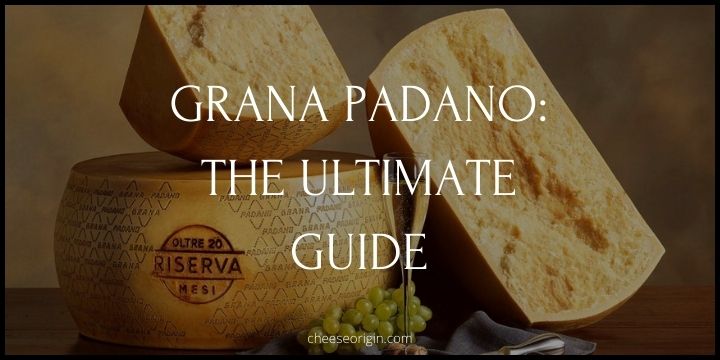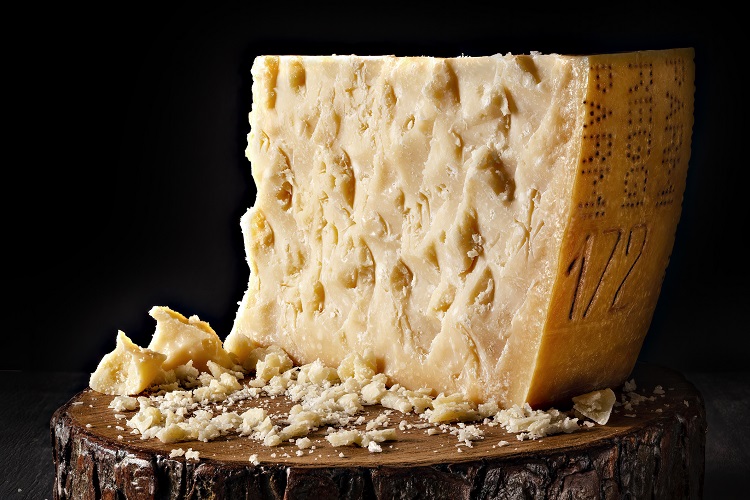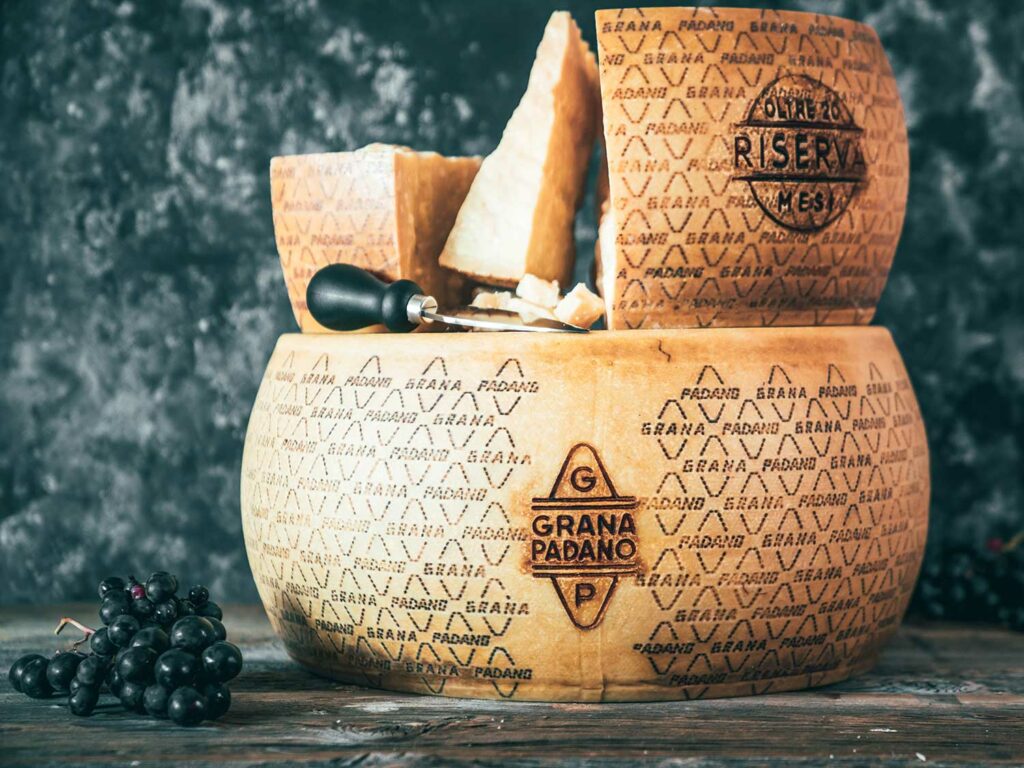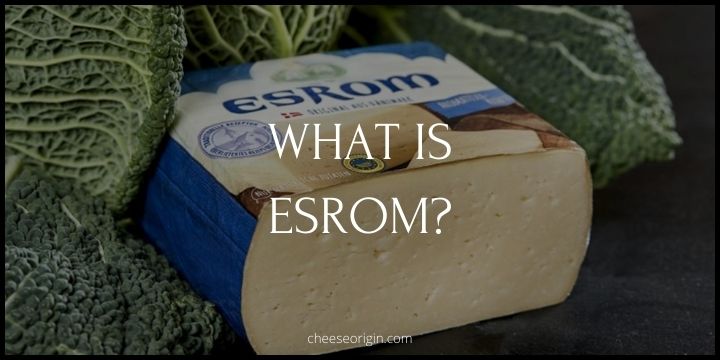What is Grana Padano? The Marvel from Italy’s Po River Valley

In the world of cheese, there are few that stand as tall or as rich in history and flavor as Grana Padano. Yet, it often gets overshadowed by its well-known cousin, Parmigiano Reggiano.
This guide aims to pull back the curtain on this underappreciated dairy marvel, taking you on a journey from the lush pastures of Northern Italy to your dinner plate.
Prepare yourself for a deep dive into the history, production process, tasting notes, and pairing suggestions of this exquisite cheese.
By the end, you’ll not only appreciate Grana Padano’s complex flavors but also understand why it holds an irreplaceable spot in Italian cuisine and beyond. So, sit back, relax, and get ready to discover Italy’s hidden gem – Grana Padano.
Quick Facts About Grana Padano
| Quick Facts | Description |
|---|---|
| Origin | Italy |
| Milk Source | Cow’s milk |
| Texture | Hard, grainy |
| Flavor | Mild, slightly sweet, nutty |
| Color | Pale yellow |
| Aging Process | Ranges from 9 months (Grana Padano), to over 20 months (Grana Padano Riserva) |
| Uses | Ideal for grating over pasta, risotto, salads or eaten alone |
| Production Process | Partially skimmed, raw cow’s milk is mixed with natural whey culture and calf rennet |
What is Grana Padano?
Grana Padano is a type of hard, slow-ripened, semi-fat Italian cheese that’s similar to Parmigiano Reggiano. It’s named after the noun ‘grana’, which refers to the grainy texture of the cheese, and ‘Padano’, referring to the Po river valley in Italy where the cheese originated.
The cheese is made from partially skimmed, raw cow’s milk mixed with natural whey culture and calf rennet. The flavor of Grana Padano varies with age; it can range from mild and buttery when young to more robust and full-bodied as it matures. It has a sweet and nutty flavor with a creamy texture.
Grana Padano is typically aged between 9 months to over 20 months. It’s ideal for grating over pasta, risotto, salads, or it can be enjoyed on its own.
One important characteristic of Grana Padano is its Protected Designation of Origin (PDO) status. This means that the cheese can only be produced in certain regions of Italy following strict traditional methods.
What does Grana Padano cheese taste like?
Grana Padano is a hard, slow-ripened, semi-fat cheese from Italy, comparable to Parmigiano Reggiano or “Parmesan”. Its flavor is complex and nuanced, reflecting its long maturation process.
The cheese has a delicate, fragrant aroma with a slightly sweet, nutty flavor. It’s not as sharp or salty as some other hard cheeses, which makes it more versatile in cooking. The texture of Grana Padano is crumbly and grainy (hence the name ‘Grana’) but becomes creamier as it ages.
Its flavor can also vary depending on its age:
| Age Category | Texture | Flavor |
|---|---|---|
| Young (9-16 months) | Softer, creamier texture | Mild, milky flavor |
| Over-seasoned (over 16 months) | Begins to get grainy and crumbly | Richer, fuller with savory and umami notes |
| Riserva (over 20 months) | Grainy, crumbly, and dense | Deep savory, complex flavors |
Grana Padano tasting notes
- Delicate, fragrant aroma
- Slightly sweet and nutty flavor
- Not overly sharp or salty, milder than some hard cheeses
- Texture is grainy and crumbly, becoming creamier with age
- Young Grana Padano (9-16 months) has a mild, milky flavor
- Over-seasoned Grana Padano (over 16 months) has a richer, fuller flavor with savory and umami notes
- Grana Padano Riserva (over 20 months) offers deep savory, complex flavors
- The taste can vary depending on what it’s paired with.
Which is better Parmesan Reggiano or Grana Padano?
Whether Parmigiano Reggiano or Grana Padano is better largely depends on personal taste and the specific use in a dish.
| Characteristics | Parmigiano Reggiano | Grana Padano |
|---|---|---|
| Origin | Emilia-Romagna and Lombardy regions of Italy | Po River Valley, Italy |
| Ageing Process | Minimum of 12 months, often aged up to 36 months | Minimum of 9 months, can be aged up to over 20 months |
| Texture | Hard, grainy, and crystalline | Varies from creamy (younger) to grainy (older) |
| Flavor | Robust, savory, and complex | Mild, buttery, and delicate with notes of broth or steamed vegetables |
| Use in Dishes | Great for dishes where cheese stands out, or served alone | Best for dishes where cheese blends in and complements other ingredients |
| Price | Generally more expensive | Generally less expensive |
Parmigiano Reggiano:

Parmigiano Reggiano generally offers a more decisive flavor. It’s often described as more robust, savory, and complex compared to Grana Padano. This makes it a great choice for dishes where you want the cheese to stand out, or when you’re serving it on its own as part of a cheese plate.
Grana Padano:

On the other hand, Grana Padano is typically described as butterier, softer, and more delicate in flavor. Some say it has notes of broth or steamed vegetables. Its creamier texture and milder flavor can make it a better choice for dishes where you want the cheese to blend in and complement other ingredients, rather than standing out.
In terms of popularity, while Parmigiano-Reggiano may enjoy a greater level of importance in the minds of consumers, Grana Padano is actually the best-selling PDO cheese.
The truth is, both cheeses have their unique qualities that make them special. The “better” cheese would depend on your personal preference and the flavor profile you’re looking for in your dishes.
Is Grana Padano the same as Parmesan?
No, Grana Padano and Parmesan (Parmigiano-Reggiano) are not the same, although they are often confused due to their similarities.
Both are hard, grainy cheeses from Italy with similar uses in cooking, but there are key differences between them:
- Origin: Parmigiano-Reggiano is made in a restricted area in the Emilia-Romagna and Lombardy regions of Italy, while Grana Padano can be made anywhere in the Po River Valley, which spans a larger area across Northern Italy.
- Production Regulations: The production of Parmigiano-Reggiano is regulated more strictly. For example, cows used for Parmigiano-Reggiano must only be fed grass or hay, while those used for Grana Padano can also be fed silage (fermented, high-moisture stored fodder).
- Ageing: Parmigiano-Reggiano is aged for a longer period of time, typically between 12 and 36 months, while Grana Padano is usually aged between 9 and 20 months. This results in a deeper flavor for Parmigiano-Reggiano.
- Flavor and Texture: Parmigiano-Reggiano tends to have a more robust, complex flavor and a slightly drier, crumblier texture than Grana Padano, which is milder and creamier.
- Price: Parmigiano-Reggiano is generally more expensive than Grana Padano due to its longer ageing and stricter production regulations.
>> Click here to read our in-depth guide on Parmesan
Why is Grana Padano cheaper than Parmesan?
Grana Padano is usually cheaper than Parmesan (Parmigiano-Reggiano) primarily due to differences in their production regulations and ageing process.
1. Production Regulations:
The rules for producing Parmigiano-Reggiano are more stringent compared to Grana Padano. For instance, cows used for Parmigiano-Reggiano must only be fed grass or hay, while those used for Grana Padano can also be fed silage. This stricter regulation increases the cost of production for Parmigiano-Reggiano.
2. Ageing Process:
Parmigiano-Reggiano is aged for a longer period of time, usually between 12 and 36 months, compared to Grana Padano which is aged between 9 and 20 months. The longer aging process adds to the cost of Parmigiano-Reggiano as it requires more time and resources.
3. Geographical Limitations:
Parmigiano-Reggiano can only be produced in a restricted area in the Emilia-Romagna and Lombardy regions of Italy. On the other hand, Grana Padano can be made anywhere in the Po River Valley, which spans a larger area across Northern Italy. This gives Grana Padano producers access to a larger supply of milk, potentially reducing costs.
Therefore, while both cheeses offer distinct flavors and textures, Grana Padano is generally a more affordable option due to its less stringent production regulations and shorter ageing process.
Can I replace Parmesan with Grana Padano?
Yes, you can replace Parmesan with Grana Padano in most recipes. Both are hard, grating cheeses with a similar texture and are often used interchangeably in cooking.
The differences are subtle and may not significantly impact the overall taste of your dish.
Is Grana Padano a good melting cheese?
Yes, Grana Padano is a good melting cheese. It has a texture that melts well, making it a popular choice for adding to sauces, risottos, or other dishes where a smooth, melted cheese is desired.
Its flavor is also relatively mild, which means it can add richness and depth to a dish without overpowering other flavors.
It’s often used in Italian cuisine for dishes like pasta, polenta, and pizza.
However, remember that the flavor becomes more intense with aged Grana Padano, so choose the age based on your preference for a milder or stronger flavor.
Why is Grana Padano so good?
| Characteristics | Description |
|---|---|
| Flavor Profile | Grana Padano has a complex, nutty, and slightly sweet flavor. The taste can range from mild to sharp depending on its aging process. This makes it versatile in many dishes, from grating over pasta to being eaten on its own. |
| Texture | It’s a hard cheese with a grainy texture that melts well, making it an excellent choice for cooking and baking. |
| Quality Control | The production of Grana Padano follows strict guidelines to ensure high quality. Only the best cheese, which passes rigorous testing, receives the Grana Padano PDO (Protected Designation of Origin) stamp. |
| Nutritional Value | Grana Padano is rich in protein, vitamins, and minerals. It’s naturally lactose-free due to its long maturation process, making it a good choice for those with lactose intolerance. |
| Affordability | While it’s a premium cheese, Grana Padano is typically less expensive than similar cheeses such as Parmigiano-Reggiano, making it a more accessible choice for many people. |
| Versatility | Grana Padano can be used in a variety of dishes including pasta, risotto, soups, and salads or it can be enjoyed on its own with a glass of wine. Its versatility in the kitchen contributes to its popularity. |
7 best Grana Padano substitutes (alternatives)
- Aged Asiago Cheese: This Italian cheese also has a hard texture suitable for grating and a flavor that can vary from mild to sharp depending on its aging.
- Pecorino Romano Cheese: Made from sheep’s milk, it’s saltier and has a stronger flavor compared to Grana Padano.
- Dry Jack Cheese: An American cheese that is firm, nutty, and slightly sweet, similar to Grana Padano.
- Piave Cheese: An Italian cow’s milk cheese that’s flavorful and slightly sweet, making it a good substitute for Grana Padano.
- Gouda Cheese: Although typically softer and milder than Grana Padano, aged Gouda can have a similar flavor profile.
- Manchego Cheese: A Spanish sheep’s milk cheese that’s firm and nutty, similar to an aged Grana Padano.
- Parmesan Cheese: Similar to Grana Padano in terms of texture and aging process, but slightly sharper in taste.
These alternatives can be used interchangeably in recipes depending on your personal preference and the specific requirements of the dish you’re preparing.
What pairs well with Grana Padano?
Food that goes well with Grana Padano
| Category | Foods |
|---|---|
| Pasta Dishes | Spaghetti, Lasagna, Fettuccine Alfredo |
| Rice Dishes | Risotto, Rice Pilaf |
| Breads and Baked Goods | Baguettes, Crackers, Croissants |
| Meats | Prosciutto, Salami, Pepperoni |
| Fruits | Apples, Pears, Dried Fruits, Figs |
| Vegetables | Olives, Tomatoes, Grilled Vegetables |
| Other | Soups, Broths, Honey, Nuts |
Also read: 11 Best Crackers that Pair Well with Cheese
Beverage that goes well with Grana Padano
| Category | Beverages |
|---|---|
| Wine | Chianti Classico, Merlot, Prosecco, Sangiovese, Brunello di Montalcino |
| Cocktails | Bellini |
| Non-Alcoholic | Tea |
Also read: Best Wine and Cheese Pairings: The Ultimate Guide
Is Grana Padano Healthy?
Yes, Grana Padano is generally considered healthy when consumed in moderation. Its health benefits are numerous:
- Hypertension Reduction: Consuming an ounce of Grana Padano daily may help to ease hypertension, potentially lowering blood pressure by as much as 8/7mmHg over a two month period. This is a significant benefit for those with high blood pressure.
- Rich in Nutrients: Grana Padano is a rich source of vitamin B12, which contributes to the normal function of the nervous system and helps to reduce tiredness and fatigue. It’s also rich in protein, essential for building and repairing tissues.
- Bone Health: It’s high in calcium, promoting strong bones and teeth. In fact, it contains 1165mg of calcium per 100 grams.
- Lower Fat Content: Being made from partially skimmed milk, Grana Padano is technically a semi-fat cheese. A 50g portion contains approximately 30% fat, which is mostly good fats.
- Lower Cholesterol Levels: It contains lower cholesterol levels (54 mg per 100 g) compared to some other aged cheeses, making it an appealing choice for those seeking to enjoy a flavorful cheese while maintaining a healthier diet.
Despite these benefits, like all cheeses, Grana Padano should be eaten in moderation due to its high sodium and saturated fat content. Always consult a healthcare professional or a dietitian if you have specific dietary concerns or health conditions.
Grana Padano nutrition facts
| Nutrient | Value per 100g |
|---|---|
| Calories | 398 |
| Protein | 32.14g |
| Total Fat | 28.57g |
| Carbohydrates | 0g |
| Dietary Fiber | 0g |
| Calcium | Over 600mg |
| Saturated Fat | Approximately 30% of the fat content |
| Cholesterol | 54mg |
| Sodium | Varies |
Is Grana Padano lactose-free?
Yes, Grana Padano is naturally lactose-free. The characteristics of its production and aging process result in a cheese that is safe for individuals with lactose intolerance to consume.
Even a “young” Grana Padano ages for at least nine months, which helps to minimize its lactose content. Consequently, individuals with lactose intolerance can confidently enjoy Grana Padano.
What are the ingredients in Grana Padano?
Grana Padano cheese is made with a few simple, high-quality ingredients:
- Partially Skimmed Cow’s Milk: The milk used in Grana Padano is usually obtained from cows that are milked twice a day. Their diet is regulated by the Grana Padano Protection Consortium to ensure it is free of fermented feeds and silage.
- Salt: Salt is used to enhance the flavor of the cheese and also acts as a natural preservative.
- Rennet: Rennet, a natural enzyme found in the stomachs of ruminant animals, is used to coagulate the milk, turning it into curd.
- Calf Rennet: This is added to help break down the milk proteins and start the process of turning milk into cheese.
- Fermented Whey: This is a natural lactic bacteria that helps to ferment the milk, contributing to the cheese’s unique flavor and texture.
Can you make carbonara with Grana Padano?
Yes, you can definitely make carbonara with Grana Padano. In fact, it’s a common substitute for Parmesan cheese in this classic Italian dish. Here’s a simple Spaghetti Carbonara recipe using Grana Padano:
Ingredients:
- 200g spaghetti
- 100g pancetta or guanciale (Italian cured pork cheek)
- 2 large eggs
- 50g Grana Padano cheese, finely grated
- Freshly ground black pepper
- Salt
Instructions:
- Cook the spaghetti in a large pot of boiling salted water until al dente.
- Meanwhile, fry the pancetta in a hot pan without oil until it’s crispy and the fat has rendered out.
- In a separate bowl, beat the eggs and mix in most of the Grana Padano. Season with a little bit of black pepper (not too much, the pancetta is already quite salty).
- Once the spaghetti is done, reserve some of the pasta water, then drain the spaghetti.
- Add the drained hot spaghetti to the pan with the pancetta. Toss well to coat in the fat.
- Remove the pan from the heat and add a tiny bit of the reserved pasta water and the egg and cheese mixture. Stir quickly until the eggs slightly thicken but do not scramble. The heat of the spaghetti will cook the egg slightly and create a creamy sauce. If it’s too thick, add a bit more pasta water.
- Serve immediately, sprinkled with the rest of the cheese and a bit more pepper. Enjoy!
The key to a good carbonara is to work quickly to ensure that the residual heat from the pasta cooks the egg just enough to create a creamy sauce without scrambling it.
The history of Grana Padano

Grana Padano is one of the world’s oldest hard cheeses. Its origins date back to around 1135 AD, when it was created by the monks of Chiaravalle Abbey in the Po River Valley region of northern Italy.
The monks were seeking a way to use surplus milk and create a cheese that could be stored for an extended period. They developed a method of making large wheels of cheese from partially skimmed cow’s milk, which were then aged to develop their distinctive flavor and grainy texture, hence the name “Grana,” meaning “grainy” in Italian.
Over the centuries, the production of Grana Padano spread throughout the Po River Valley, a region renowned for its fertile pastures and high-quality dairy farming. The cheese became a staple in the diet of people living in this region and was often used as a form of currency.
In 1954, the Grana Padano Protection Consortium was established to regulate the production of the cheese and protect its name. In 1996, Grana Padano received Protected Designation of Origin (PDO) status from the European Union, recognizing its unique connection to its place of origin.
Today, Grana Padano is one of Italy’s most popular cheeses, celebrated for its rich, nutty flavor and versatility in cooking. It continues to be made according to traditional methods, with each wheel carefully inspected and fire-branded by the Consortium to ensure its quality and authenticity.
Frequently Asked Questions
1. Can you eat Grana Padano raw by itself?
Absolutely, you can enjoy Grana Padano cheese raw and by itself! Its rich, full-bodied flavor and slightly grainy texture make it a delightful standalone snack. When eaten raw, the distinct taste notes of this cheese – buttery, nutty, and slightly sweet – can be savored to their fullest.
It’s a perfect accompaniment to a glass of wine or fresh fruit.
Remember, Grana Padano is a hard cheese, so it’s best served at room temperature to allow its complex flavors to fully unfold.
2. Why is it called Grana Padano?
The name “Grana Padano” is deeply rooted in the cheese’s origins and characteristics.
The term “Grana” translates to “grainy” in Italian, which perfectly describes the cheese’s unique, crumbly and grainy texture. This texture is a result of the long aging process, which allows proteins and fats to break down into smaller, grain-like clusters.
The second part of the name, “Padano”, refers to the geographical region of the Po River Valley, or Pianura Padana in Italian.
This fertile region spanning across Northern Italy is where the cheese was first produced over a thousand years ago and continues to be its main production area.
Hence, Grana Padano literally translates to the ‘grainy cheese from the Po River Valley’.
3. Is Grana Padano a strong cheese?
No. Instead, Grana Padano is often characterized by its distinctive yet balanced flavor profile. It’s a hard cheese that carries a somewhat sharp, savory taste, which becomes more pronounced as the cheese ages.
However, compared to some other Italian cheeses like Parmigiano Reggiano, Grana Padano is generally considered milder.
It offers a nuanced blend of flavors, combining notes of nuttiness with a hint of sweetness and a subtle fruity undertone.
This makes Grana Padano less overpowering and more versatile, suitable for a range of dishes as well as being enjoyed on its own.
4. How do I store Grana Padano?
Here are some tips for storing this cheese:
- Refrigeration: After purchasing, Grana Padano should be kept in the refrigerator, ideally between 4°C and 8°C (39°F – 46°F).
- Proper Wrapping: Wrap the cheese in wax paper or parchment paper, which allows it to breathe while preventing it from drying out. Avoid using plastic wrap as it can cause the cheese to sweat and impact its flavor.
- Avoid Cross-Contamination: Store your cheese separately from other strong-smelling foods to prevent it from absorbing their flavors. A dedicated cheese drawer or a sealed container can help with this.
- Serving Size: Only cut off as much cheese as you plan to use immediately. The rest of the cheese will stay fresher if it remains uncut.
- Resting: Before eating, take the cheese out of the refrigerator and let it come to room temperature for about an hour. This will enhance its flavor and texture.
Remember, it’s best to consume Grana Padano within a few weeks of opening for the best taste and quality.
If you notice any mold growth, it’s generally safe to remove it and eat the rest of the cheese, but if the mold has spread significantly, it’s best to discard the whole piece.
Also read: What’s the Best Way to Store Cheese?
5. Is Grana Padano pasteurised?
Grana Padano is traditionally made with unpasteurized, semi-skimmed cow’s milk. The process of making this cheese involves a natural creaming process that helps to maintain its authentic flavor and texture.
However, there can be variations, and some versions of Grana Padano may be made from pasteurized milk. It’s always important to check the specific product details if you have any concerns, particularly for people like pregnant women who are often advised to consume only cheeses made from pasteurized milk.
Despite being usually made from unpasteurized milk, Grana Padano is considered safe to eat during pregnancy due to its long aging process, which helps eliminate harmful bacteria.
6. How to pronounce ‘Grana Padano’?
Its pronunciation in English would be: “GRAH-nah pah-DAH-no”.
Here’s a breakdown:
- “Grana”: The ‘a’ in both syllables is pronounced like the ‘a’ in “father.” So it’s “GRAH-nah.”
- “Padano”: The ‘a’ is again pronounced like the ‘a’ in “father,” and the ‘o’ at the end is pronounced like the ‘o’ in “no.” So it’s “pah-DAH-no.”
Remember, the emphasis is on the second syllable of “Padano” – DAH.
Also read:
- The Ultimate Guide to Gruyère: A Swiss Delicacy
- Mastering the Art of Smoked Gouda: Your Ultimate Cheese Guide
- Comté Cheese: The Golden Essential of Every Cheeseboard
- Utz Cheese Balls: The Ultimate Guide (Taste the Tradition)
- The Ultimate Guide to Raclette Cheese: A Melted Delight
- Cheese Curds: The Unsung Heroes of the Dairy World
- Fior di Latte: A Comprehensive Guide to Italy’s Creamy Delight





